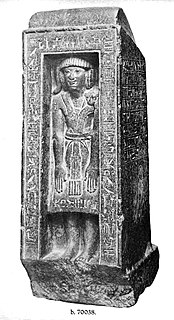 W
WAkhenaten, also spelled Echnaton, Akhenaton, Ikhnaton, and Khuenaten, was an ancient Egyptian pharaoh reigning c. 1353–1336 or 1351–1334 BC, the tenth ruler of the Eighteenth Dynasty. Before the fifth year of his reign, he was known as Amenhotep IV.
 W
WAmenhotep, son of Hapu was an ancient Egyptian architect, a priest, a scribe, and a public official, who held a number of offices under Amenhotep III of the 18th Dynasty.
 W
WAtenism, the Aten religion, the Amarna religion, or the "Amarna heresy" was a religion and the religious changes associated with the ancient Egyptian Eighteenth Dynasty pharaoh Akhenaten. The religion centered on the cult of the god Aten, depicted as the disc of the Sun and originally an aspect of the traditional solar deity Ra. In the 14th century BC, Atenism was Egypt's state religion for about 20 years, before subsequent rulers returned to the traditional polytheistic religion and the pharaohs associated with Atenism were erased from Egyptian records.
 W
WThe Eighteenth Dynasty of Egypt is classified as the first dynasty of the New Kingdom of Egypt, the era in which ancient Egypt achieved the peak of its power. The Eighteenth Dynasty spanned the period from 1549/1550 to 1292 BC. This dynasty is also known as the Thutmosid Dynasty for the four pharaohs named Thutmose.
 W
WMery was a High Priest of Amun from the time of Amenhotep II.
 W
WNeferneferuaten Nefertiti was a queen of the 18th Dynasty of Ancient Egypt, the Great Royal Wife of Pharaoh Akhenaten. Nefertiti and her husband were known for a religious revolution, in which they worshipped one god only, Aten, or the sun disc. With her husband, she reigned at what was arguably the wealthiest period of Ancient Egyptian history. Some scholars believe that Nefertiti ruled briefly as Neferneferuaten after her husband's death and before the ascension of Tutankhamun, although this identification is a matter of ongoing debate. If Nefertiti did rule as Pharaoh, her reign was marked by the fall of Amarna and relocation of the capital back to the traditional city of Thebes.
 W
WPtahmose was High Priest of Ptah in Memphis during the time of Thutmose III of the 18th Dynasty.
 W
WSimut or Samut was an ancient Egyptian priest who held the position of Second Prophet of Amun towards the end of the reign of Pharaoh Amenhotep III. He is known from a number of objects, including his, Theban tomb chapel Tomb A.24.
 W
WThuty or Djehuty was a High Priest of Amun from the time of Ahmose I, at the beginning of the 18th Dynasty.